Mike Oldfield: Hergest Ridge
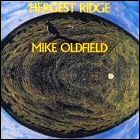 Virgin Records releases Mike Oldfield‘s second prog-rock instrumental album, Hergest Ridge, the eagerly-awaited follow-up to his debut LP, Tubular Bells.
Virgin Records releases Mike Oldfield‘s second prog-rock instrumental album, Hergest Ridge, the eagerly-awaited follow-up to his debut LP, Tubular Bells.
Electric Light Orchestra: On The Third Day
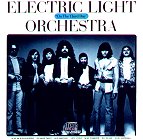 Electric Light Orchestra‘s third album, On The Third Day, is released, featuring the singles “Showdown” and “Ma-Ma-Ma Belle”.
Electric Light Orchestra‘s third album, On The Third Day, is released, featuring the singles “Showdown” and “Ma-Ma-Ma Belle”.
Roy Wood: Boulders
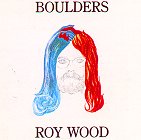 EMI Records releases Roy Wood‘s first solo album, Boulders, following his departure from The Move and Electric Light Orchestra. Aside from a single instrument on a single song, every voice and instrument on the album is performed by Wood himself.
EMI Records releases Roy Wood‘s first solo album, Boulders, following his departure from The Move and Electric Light Orchestra. Aside from a single instrument on a single song, every voice and instrument on the album is performed by Wood himself.
Electric Light Orchestra II
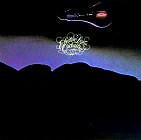 Electric Light Orchestra‘s second album is released in the UK, featuring the single “Roll Over Beethoven” and ELO’s longest song ever, “Kuiama,” clocking in at over 11 minutes.
Electric Light Orchestra‘s second album is released in the UK, featuring the single “Roll Over Beethoven” and ELO’s longest song ever, “Kuiama,” clocking in at over 11 minutes.
Moody Blues: Seventh Sojourn
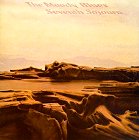 Decca Records releases the eighth album by the Moody Blues, Seventh Sojourn (the seven, in this case, referring to the seventh album by the band since the addition of Justin Hayward and John Lodge in the 1960s). The album includes the singles “Isn’t Life Strange” and “I’m Just a Singer in a Rock and Roll Band”.
Decca Records releases the eighth album by the Moody Blues, Seventh Sojourn (the seven, in this case, referring to the seventh album by the band since the addition of Justin Hayward and John Lodge in the 1960s). The album includes the singles “Isn’t Life Strange” and “I’m Just a Singer in a Rock and Roll Band”.
Electric Light Orchestra
 Electric Light Orchestra‘s self-titled debut album is released in the UK, though it proves to be the last released collaboration between founders (and former Move members) Roy Wood and Jeff Lynne; Wood leaves the band after an unpromising live debut. The album is released in the US in March 1972, where a phone call to clarify the album’s title results in a misunderstood written note that leads to the American release going out under the unintentional title No Answer.
Electric Light Orchestra‘s self-titled debut album is released in the UK, though it proves to be the last released collaboration between founders (and former Move members) Roy Wood and Jeff Lynne; Wood leaves the band after an unpromising live debut. The album is released in the US in March 1972, where a phone call to clarify the album’s title results in a misunderstood written note that leads to the American release going out under the unintentional title No Answer.
Carole King: Tapestry
 Carole King’s career-making album Tapestry is released by CBS records, featuring the singles “I Feel The Earth Move”, “(You Make Me Feel Like) A Natural Woman”, “It’s Too Late” and “You’ve Got A Friend”.
Carole King’s career-making album Tapestry is released by CBS records, featuring the singles “I Feel The Earth Move”, “(You Make Me Feel Like) A Natural Woman”, “It’s Too Late” and “You’ve Got A Friend”.
The Move: Looking On
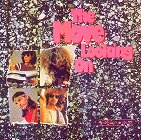 Fly Records releases the third album by Birmingham rock group The Move, Looking On. The group sports an elegant, elaborate new sound on this outing, having recruited budding songwriter/performer Jeff Lynne from another local band, the Idle Race. Lynne’s interaction with Move frontman Roy Wood will lead to the formation, a year later, of the Electric Light Orchestra.
Fly Records releases the third album by Birmingham rock group The Move, Looking On. The group sports an elegant, elaborate new sound on this outing, having recruited budding songwriter/performer Jeff Lynne from another local band, the Idle Race. Lynne’s interaction with Move frontman Roy Wood will lead to the formation, a year later, of the Electric Light Orchestra.
Moody Blues: A Question Of Balance
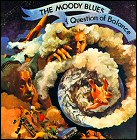 Decca Records releases the sixth album by the Moody Blues, A Question Of Balance, featuring the singles “Question” and “Melancholy Man”. Thanks to the band’s large following, the album – the second to be released by the band in 1970 – is an international bestseller.
Decca Records releases the sixth album by the Moody Blues, A Question Of Balance, featuring the singles “Question” and “Melancholy Man”. Thanks to the band’s large following, the album – the second to be released by the band in 1970 – is an international bestseller.
The Move: Shazam
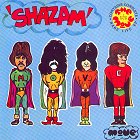 Regal Zonophone Records releases the second album by Birmingham rock group The Move, Shazam. (The album is simultaneously issued in the United States and Canada by A&M Records.) The final album with original lead singer Carl Wayne, Shazam is a bizarre collision of heavy metal and showtunes and standards without even the slightest hint of irony. After this album, Roy Wood takes over as the band’s leader.
Regal Zonophone Records releases the second album by Birmingham rock group The Move, Shazam. (The album is simultaneously issued in the United States and Canada by A&M Records.) The final album with original lead singer Carl Wayne, Shazam is a bizarre collision of heavy metal and showtunes and standards without even the slightest hint of irony. After this album, Roy Wood takes over as the band’s leader.
Moody Blues: To Our Children’s Children’s Children
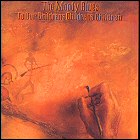 Decca Records releases the fifth album by the Moody Blues, To Our Children’s Children’s Children, featuring the single “Watching And Waiting”. This is the first of two albums the band will release in 1970.
Decca Records releases the fifth album by the Moody Blues, To Our Children’s Children’s Children, featuring the single “Watching And Waiting”. This is the first of two albums the band will release in 1970.
White Noise: An Electric Storm
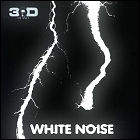 Island Records releases the debut album by White Noise, an ad hoc early electronic music group including David Vorhaus and members of the BBC Radiophonic Workshop.
Island Records releases the debut album by White Noise, an ad hoc early electronic music group including David Vorhaus and members of the BBC Radiophonic Workshop.
Iron Butterfly: In-A-Gadda-Da-Vida
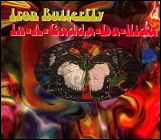 Iron Butterfly‘s psychedelic rock album In-A-Gadda-Da-Vida is released; a much-shortened version of the 17-minute (!!) song of the same name becomes a radio hit and a prime specimen of the genre.
Iron Butterfly‘s psychedelic rock album In-A-Gadda-Da-Vida is released; a much-shortened version of the 17-minute (!!) song of the same name becomes a radio hit and a prime specimen of the genre.
The Move: The Move
 Regal Zonophone Records releases the first album by The Move, a UK rock band which, after several personnel changes, will eventually morph into the Electric Light Orchestra in the 1970s. Singles include “Fire Brigade” and “Wild Tiger Woman”.
Regal Zonophone Records releases the first album by The Move, a UK rock band which, after several personnel changes, will eventually morph into the Electric Light Orchestra in the 1970s. Singles include “Fire Brigade” and “Wild Tiger Woman”.
Moody Blues: Days Of Future Passed
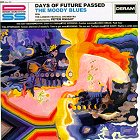 Deram Records – an offshoot of UK label Decca – releases the second Moody Blues album, Days Of Future Passed, an orchestral/rock collaboration intended to show off the company’s stereo recording techniques for classical recordings (and intended to write off the band’s massive promotional debts owed to the label). The results is a perennially popular album now regarded as a rock classic, including the enduring hit singles “Nights In White Satin” and “Forever Afternoon (Tuesday?)”.
Deram Records – an offshoot of UK label Decca – releases the second Moody Blues album, Days Of Future Passed, an orchestral/rock collaboration intended to show off the company’s stereo recording techniques for classical recordings (and intended to write off the band’s massive promotional debts owed to the label). The results is a perennially popular album now regarded as a rock classic, including the enduring hit singles “Nights In White Satin” and “Forever Afternoon (Tuesday?)”.
Mr. Spock’s Music From Outer Space
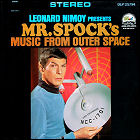 Dot Records releases the Leonard Nimoy‘s album Mr. Spock’s Music From Outer Space, a collection of songs both in and out of character as Spock. Aside from providing material for future Golden Throats albums, this record sparks a feud between Nimoy and Roddenberry; Roddenberry claims co-writing credit on the Star Trek theme (which is featured on the LP) and credit for creating Mr. Spock, and demands – to coin a phrase – a piece of the action.
Dot Records releases the Leonard Nimoy‘s album Mr. Spock’s Music From Outer Space, a collection of songs both in and out of character as Spock. Aside from providing material for future Golden Throats albums, this record sparks a feud between Nimoy and Roddenberry; Roddenberry claims co-writing credit on the Star Trek theme (which is featured on the LP) and credit for creating Mr. Spock, and demands – to coin a phrase – a piece of the action.
The Sound of Star Trek
 Halfway through filming on the Star Trek pilot episode, The Cage, the attention of the show’s producers turns to the music for the pilot, and possible composers. Among the composers approached but unable to commit to Star Trek are Jerry Goldsmith (later to score 1979‘s Star Trek: The Motion Picture), John Williams (later of Star Wars and Lost In Space fame), Lalo Schifrin (Mission: Impossible), Elmer Bernstein, and Dominic Frontiere (The Outer Limits); a young composer named Alexander Courage, whose schedule is open, is considered especially promising.
Halfway through filming on the Star Trek pilot episode, The Cage, the attention of the show’s producers turns to the music for the pilot, and possible composers. Among the composers approached but unable to commit to Star Trek are Jerry Goldsmith (later to score 1979‘s Star Trek: The Motion Picture), John Williams (later of Star Wars and Lost In Space fame), Lalo Schifrin (Mission: Impossible), Elmer Bernstein, and Dominic Frontiere (The Outer Limits); a young composer named Alexander Courage, whose schedule is open, is considered especially promising.
Raymond Scott: Soothing Sounds For Baby
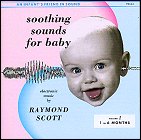 Raymond Scott‘s experimental electronic music album Soothing Sounds For Baby, Volume 1 is released. Created entirely on electronic instruments and sequencers of his own creation – decades ahead of the widespread use of such equipment – the LP is a series of somewhat repetitive instrumentals which will supposedly help infants sleep better.
Raymond Scott‘s experimental electronic music album Soothing Sounds For Baby, Volume 1 is released. Created entirely on electronic instruments and sequencers of his own creation – decades ahead of the widespread use of such equipment – the LP is a series of somewhat repetitive instrumentals which will supposedly help infants sleep better.
Ladies and gentlemen, the Beatles!
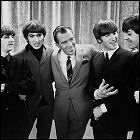 Introduced to an audience of screaming teenagers on national television, the Beatles make their American TV debut on the Ed Sullivan Show. The band, whose TV premiere takes place during their first trip to the States, play five songs to rapturous applause. (Ironically, Sullivan’s other musical act of the evening is a young actor named Davy Jones, later of the Monkees.) An audience estimated to be 73 million viewers strong watches this seismic moment in American pop culture, ushering in years of wanna-be sound-alikes both foreign and domestic referred to as the British Invasion.
Introduced to an audience of screaming teenagers on national television, the Beatles make their American TV debut on the Ed Sullivan Show. The band, whose TV premiere takes place during their first trip to the States, play five songs to rapturous applause. (Ironically, Sullivan’s other musical act of the evening is a young actor named Davy Jones, later of the Monkees.) An audience estimated to be 73 million viewers strong watches this seismic moment in American pop culture, ushering in years of wanna-be sound-alikes both foreign and domestic referred to as the British Invasion.
The BBC Radiophonic Workshop
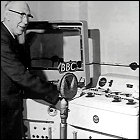 The British Broadcasting Corporation, in order to meet its producers’ requests for more unusual sound effects and music than is presently held in its sound library, establishes the BBC Radiophonic Workshop in room 13 of the BBC’s Maida Vale recording studios. Concentrating on tape manipulation and found sounds altered with analog effects (and only later delving into the earliest waves of analog synthesizers), the Workshop produces music for such legendary BBC productions as The Quatermass Experiment and the theme music for Doctor Who. Founding members include Desmond Briscoe, Daphne Oram and Dick Mills.
The British Broadcasting Corporation, in order to meet its producers’ requests for more unusual sound effects and music than is presently held in its sound library, establishes the BBC Radiophonic Workshop in room 13 of the BBC’s Maida Vale recording studios. Concentrating on tape manipulation and found sounds altered with analog effects (and only later delving into the earliest waves of analog synthesizers), the Workshop produces music for such legendary BBC productions as The Quatermass Experiment and the theme music for Doctor Who. Founding members include Desmond Briscoe, Daphne Oram and Dick Mills.